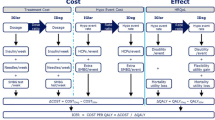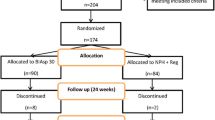Summary
BACKGROUND AND RATIONALE: Recent data suggest that insulin glargine might be a cost-effective alternative to conventional insulin therapy in patients with type 2 diabetes mellitus (T2DM). The aim of this observational study was to evaluate the treatment costs of insulin glargine in combination with oral antidiabetic drugs (OADs) compared with conventional insulin therapy in T2DM in everyday clinical practice. PATIENTS AND METHODS: Data were obtained from a cohort of 678 patients with T2DM not adequately controlled by OADs alone (HbA1c mean, 9.1 ± 1.7%). Patients received either insulin glargine in addition to oral therapy or were switched to conventional insulin therapy. Treatment and dosing decisions were made at the physician's discretion, reflecting everyday practice. Patients were followed for 2–4 months. Primary outcome parameters were total treatment costs and clinical efficacy. RESULTS: The two therapeutic regimens were equally effective in decreasing HbA1c to 7.8% (p < 10-9). Patients in the insulin glargine plus OAD group controlled their blood glucose level at endpoint with a median of 60 test strips per month; and those in the conventional insulin therapy group, with a median of 80 strips per month (p = 0.000000739). Total daily costs of insulin, needles, glycemic control, and OAD treatment per patient were similar in the two treatment groups (insulin glargine group, EUR 1.91, vs conventional group, EUR 1.99). CONCLUSION: The two treatment regimens were equally effective in improving glycemic control. These results were achieved with significantly lower insulin doses and fewer blood glucose test strips in the insulin glargine group, which therefore led to cost equivalence when compared with conventional insulin therapy.
Zusammenfassung
HINTERGRUND UND RATIONAL: Neue Studiendaten weisen darauf hin, dass Insulin glargin eine kosteneffektive Alternative zu konventioneller Insulintherapie bei Typ 2 Diabetes mellitus (T2DM) darstellt. Das Ziel dieser Anwendungsbeobachtung war es, die Therapiekosten von Insulin glargin in Kombination mit oralen Antidiabetika (OADs) im Vergleich zu konventioneller Insulintherapie bei T2DM unter den Bedingungen der täglichen klinischen Praxis zu erheben. PATIENTEN UND METHODE: Die Daten von 678 Patienten mit T2DM, die mit OADs alleine unzureichend eingestellt waren (mittlerer HbA1c, 9,1 ± 1,7 %) wurden erfasst. Die Patienten erhielten entweder Insulin glargin in Kombination mit OADs oder wurden auf konventionelle Insulintherapie mit Mischinsulin umgestellt. Die Entscheidung bezüglich Behandlung und Dosierung oblag dem behandelnden Arzt, um praxisnahe klinische Alltagsbedingungen zu dokumentieren. Der Beobachtungszeitraum erstreckte sich über 2–4 Monate. Die primären Erhebungsparameter waren Behandlungskosten und klinische Wirksamkeit. ERGEBNISSE: Beide Therapiearme waren in Bezug auf den mittleren HbA1c-Wert bei Studienende (7,8 %, p < 10-9) gleich wirksam. Am Ende des Beobachtungszeitraumes kontrollierten Patienten in der Insulin-glargin-plus-OAD-Gruppe ihre Blutglukosespiegel mit einem Median von 60 Messstreifen pro Monat, jene in der Gruppe mit konventioneller Insulintherapie mit einem Median von 80 Messstreifen pro Monat (p = 0,000000739). Die Gesamtkosten der Behandlung pro Patient pro Tag, bestehend aus Kosten für Insulin, Nadeln, Blutzuckermessstreifen, Lanzetten und oralen Antidiabetika, waren für beide Behandlungsgruppen ähnlich (Insulin-glargin-Gruppe, EUR 1,91, vs. Mischinsulin-Gruppe, EUR 1,99). SCHLUSSFOLGERUNGEN: Beide Behandlungsregime waren bezüglich der verbesserten Blutglukosekontrolle gleich wirksam. In der Insulin-glargin-Gruppe wurden die Ergebnisse mit signifikant geringerer Insulindosis und weniger Blutzuckermessstreifen erreicht, was zu einer Kostenäquivalenz im Vergleich zu konventioneller Insulintherapie führte.
Similar content being viewed by others
Author information
Authors and Affiliations
Corresponding author
Rights and permissions
About this article
Cite this article
Lechleitner, M., Roden, M., Haehling, E. et al. Insulin glargine in combination with oral antidiabetic drugs as a cost-equivalent alternative to conventional insulin therapy in type 2 diabetes mellitus. Wien Klin Wochenschr 117, 593–598 (2005). https://doi.org/10.1007/s00508-005-0429-5
Received:
Accepted:
Issue Date:
DOI: https://doi.org/10.1007/s00508-005-0429-5




